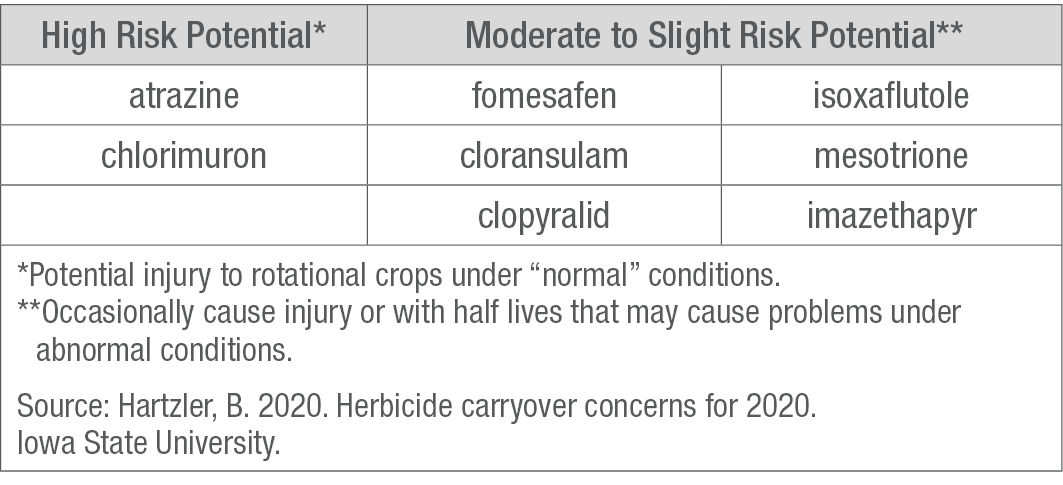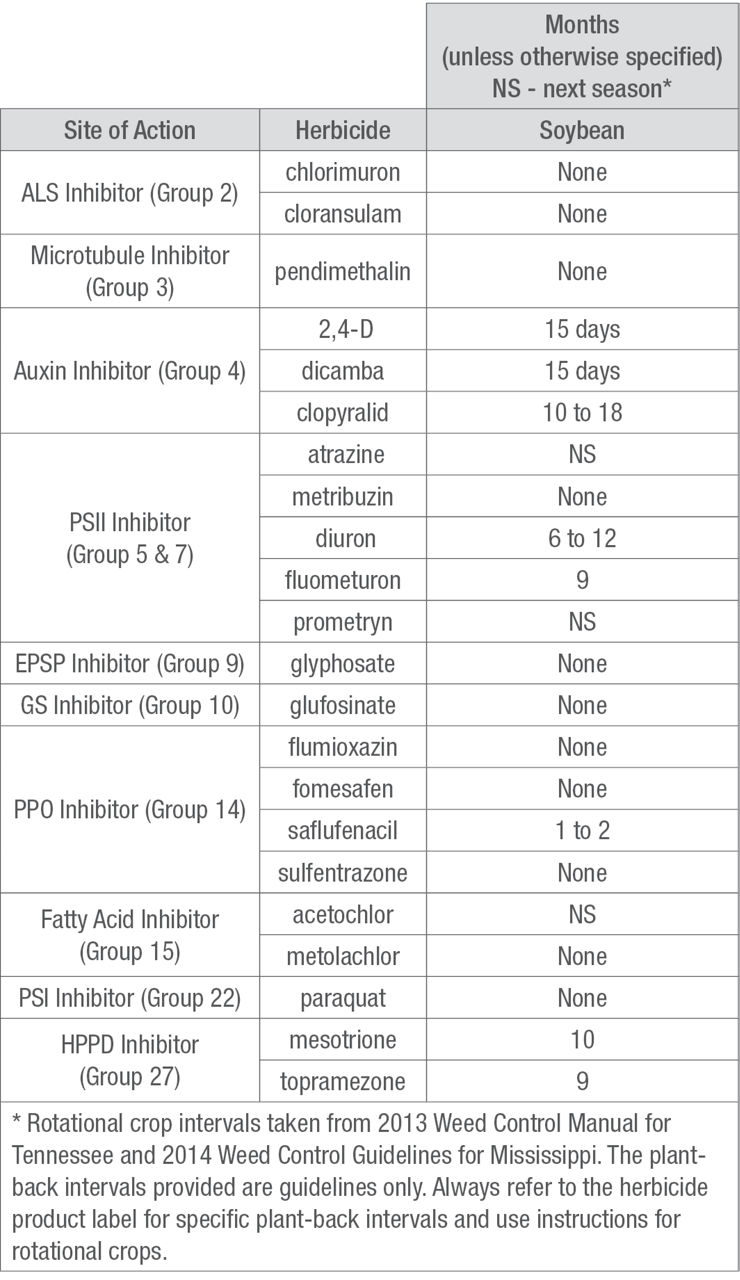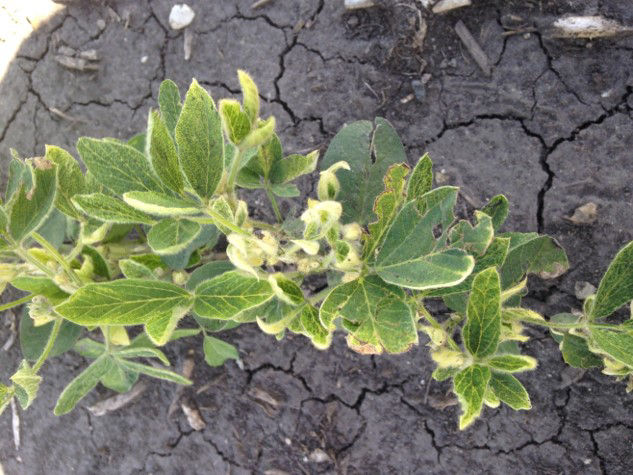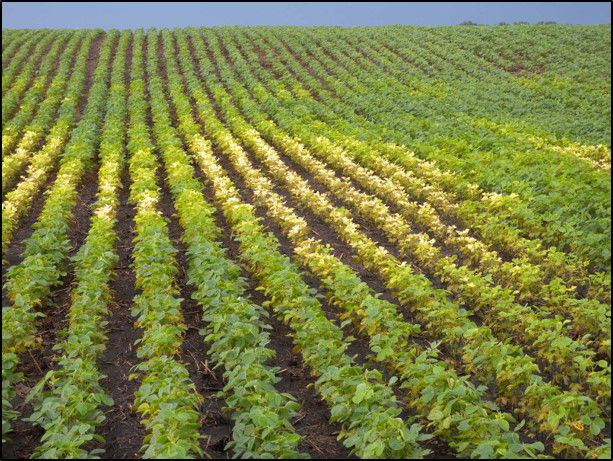7 MIN READ
Herbicide Carryover and Crop Rotation to Soybean
July 12, 2023
Introduction
Herbicides are applied for weed control in most agronomic crops. Understanding how long they persist, or the length of time they remain active in the soil, is important to prevent potential carryover injury to subsequent crops, including soybeans. The potential for carryover injury to rotational crops is influenced by the amount of herbicide present in the soil, the susceptibility of the rotational crop, and conditions that occur after application. The herbicide label is the primary source of information on possible carryover and plant back restrictions, it should be read and understood, prior to any application.
The potential for herbicide carryover injury include:
- persistence of the herbicide
- herbicide rate
- soil characteristics
- amount of rainfall during the season following the application
- length of interval between herbicide application and planting the rotational crop
- sensitivity of the crop to the herbicide
- early-season crop vigor1
Herbicide Chemistry
Herbicides differ from one another by their chemical properties which affect persistence in the soil. The most important factor to keep in mind is a product’s half-life– the amount of time it takes for 50% of the specific herbicide to break down in the soil, either by microbial or chemical degradation. Herbicides that remain active in the soil for long periods of time pose the greatest threat to rotational crops. Most herbicides that pose a carryover impact have re-cropping intervals of 9 to 10 months or longer. Herbicide families with persistent active ingredients include triazines (e.g. atrazine), phenylureas (e.g. diuron), sulfonylureas (e.g. chlorimuron), imadazolinones (e.g. imazaquin), dinitroanilines (e.g. trifluralin), isoxazolidinones (e.g. clomazone), and diphenylethers (e.g., fomesafen).
Rate and Timing of Application
The rate of herbicide application and seasonal timing impact carryover. Misapplication, either by applying more than the labelled rate or overlapping spray patterns, increases the potential for herbicide carryover. Growers should review the herbicide label on re-cropping restrictions to ensure the application window has not been exceeded when later applications are used.
Environmental Conditions
Weather is another major factor in herbicide carryover. Soil moisture and warm temperatures increase soil microbial activity resulting in a higher rate of degradation of herbicide residues. Under extremely dry conditions the rate of herbicide degradation by soil microbes can be slow enough to allow herbicides to persist into the next season. Cold soil temperatures decrease microbial activity, and moisture during the winter may not increase microbial activity enough to enhance the rate of herbicide degradation. Late spring or summer herbicide applications followed by dry weather conditions and cool temperatures that extend into early spring can result in herbicide carryover problems.2
Soil Properties
Soil properties can make a difference in herbicide persistence. Soils with higher amounts of organic matter (OM) and clay tend to have a greater potential for herbicide carryover. Finer textured soils with a high percentage of OM and clay slow plant herbicide uptake, the downward movement of herbicides in the soil, and microbial degradation of herbicide residue. Potential injury to rotational crops can then occur by the release of herbicide residues that have been bound to the soil in the spring.
Soil pH is another factor that can affect herbicide persistence and availability. For example, high soil pH (>7.5) can lead to greater carryover of triazine and sulfonylurea herbicides while imazethapyr is more likely to cause injury in soils with a pH lower than 6.5.2
Soil microbes are responsible for most herbicide degradation. Coupled by warm temperatures, adequate moisture, good aeration, and fertility in a soil with a neutral pH around 7.0 results in faster degradation of herbicides.
Rotational Crop Sensitivity to Herbicide
Several herbicides or pre-mixtures used in corn production have longer crop rotational intervals, which can indicate the potential for longer persistence in the soil, particularly during dry conditions (Table 1). The HPPD inhibitor (Group 27) herbicides are labeled for pre- and post-emergence applications in corn and are part of several pre-mix herbicide products. Under normal conditions these herbicides have a low risk of carryover, but dry conditions during the previous season followed by a cold, wet spring has been shown to contribute to the carryover potential of these herbicides and injury to soybeans. Low soil moisture, cool temperatures, and changes in soil pH can inhibit microbial degradation. HPPD carryover injury to soybean has occurred in spray overlap areas where elevated application rates increased the risk for carryover.
Table 1. Common herbicide active ingredients (group/site of action) with carryover potential.

Fall-seeded crops and cover crops may also have limited tolerance to some herbicide with residual activity.3 Cropping plans may need to be changed in fields where carryover could occur. Good weed management planning and recordkeeping is necessary to help minimize potential carryover to rotational crops.
Crop rotational intervals can vary between herbicides within the same group, local environmental conditions, and use practices (Table 2). Product users should consult individual product labels for specific recommendations and precautions. Information on herbicide characteristics, crop tolerance, and performance under local conditions should be obtained from local experts.
Table 2. Crop rotational guidelines for some common herbicide active ingredients.

Canada re-cropping restrictions for planting soybean crop after commonly used herbicides the previous year can often be found for the province that the crop will be grown in. Such guidelines for Ontario can be found in in the OMAFRA publication 75A Guide to weed control.
How to Minimize the Chance of Herbicide Carryover
- Always read and comprehend the herbicide label and follow crop rotation intervals.
- Keep records of which fields received a residual herbicide with application dates and rates.
- Make applications early to control weeds and try to minimize late-season applications.
- Be careful during application to apply the correct rate and avoid boom overlaps in the field.
- If you know conditions are likely for carryover injury, plant the same crop as the previous year.
- Consider tillage in fall and spring to help dilute herbicide residues and encourage breakdown.
- Maintain a medium soil pH to reduce herbicide carryover potential.2


Sources:
1 Hartzler, B. 2020. Herbicide Carryover concerns for 2020. Iowa State University Extension and Outreach. https://crops.extension.iastate.edu/blog/bob-hartzler/herbicide-carryover-concerns-2020.
2 Ikley, J. and Johnson, B. 2018. Factors Affecting Herbicide Carryover in 2018. Purdue University. Extension Entomology. Pest&Crop Newsletter. https://extension.entm.purdue.edu/newsletters/pestandcrop/article/factors-affecting-herbicide-carryover-in-2018/
3 2018. Using herbicides and cover crops in corn and soybean. University of Minnesota Extension.
https://extension.umn.edu/cover-crops/using-herbicides-and-cover-crops-corn-and-soybean.
Web sources verified 05/17/23. 1323_102342